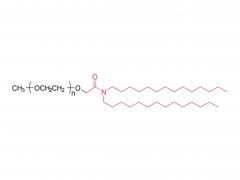Int J Biol Macromol. 2018 May:111:1032-1039. doi: 10.1016/j.ijbiomac.2018.01.134. Epub 2018 Jan 31.
SS-mPEG chemical modification of recombinant phospholipase C for enhanced thermal stability and catalytic efficiency
Xian Fang 1, Xueting Wang 1, Guiling Li 2, Jun Zeng 2, Jian Li 2, Jingwen Liu 3
Abstract
PEGylation is one of the most promising and extensively studied strategies for improving the properties of proteins as well as enzymic physical and thermal stability. Phospholipase C, hydrolyzing the phospholipids offers tremendous applications in diverse fields. However, the poor thermal stability and higher cost of production have restricted its industrial application. This study focused on improving the stabilization of recombinant PLC by chemical modification with methoxypolyethylene glycol-Succinimidyl Succinate (SS-mPEG, MW 5000). PLC gene from isolate Bacillus cereus HSL3 was fused with SUMO, a novel small ubiquitin-related modifier expression vector and over expressed in Escherichia coli. The soluble fraction of SUMO-PLC reached 80% of the total recombinant protein. The enzyme exhibited maximum catalytic activity at 80 °C and was relatively thermostable at 40-70 °C. It showed extensive substrate specificity pattern and marked activity toward phosphatidylcholine, which made it a typical non-specific PLC for industrial purpose. SS-mPEG-PLC complex exhibited an enhanced thermal stability at 70-80 °C and the catalytic efficiency (Kcat/Km) had increased by 3.03 folds compared with free PLC. CD spectrum of SS-mPEG-PLC indicated a possible enzyme aggregation after chemical modification, which contributed to the higher thermostability of SS-mPEG-PLC. The increase of antiparallel β sheets in secondary structure also made it more stable than parallel β sheets. The presence of SS-mPEG chains on the enzyme molecule surface somewhat changed the binding rate of the substrates, leading to a significant improvement in catalytic efficiency. This study provided an insight into the addition of SS-mPEG for enhancing the industrial applications of phospholipase C at higher temperature.
Keywords: Enzymatic properties; Phospholipase C; Recombinant expression; SS-mPEG modification; Thermal stability and catalytic efficiency.
Related products
Abbreviation: mPEG-SS
Name: Methoxypoly(ethylene glycol) succinimidyl succinate
For more product information, please contact us at:
US Tel: 1-844-782-5734
US Tel: 1-844-QUAL-PEG
CHN Tel: 400-918-9898
Email: sales@sinopeg.com





















